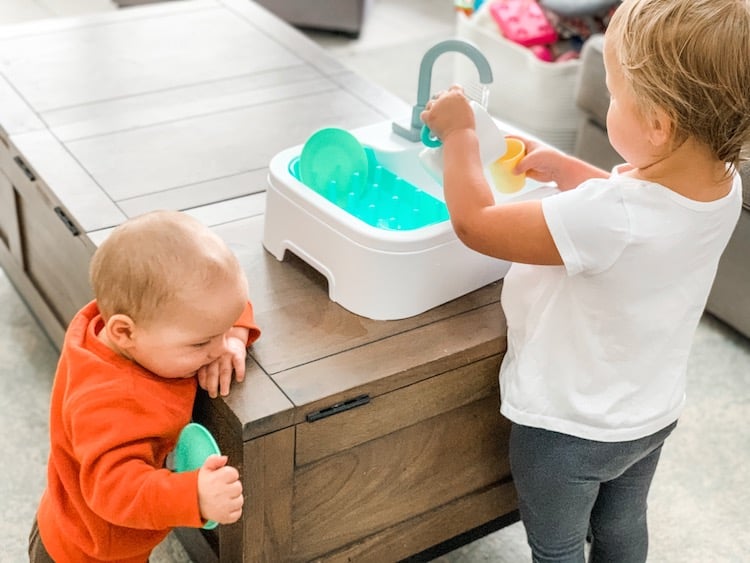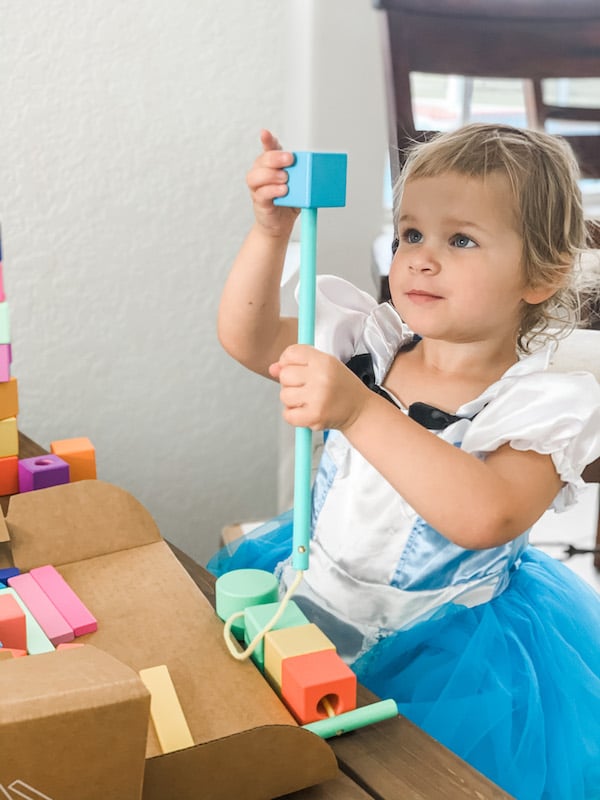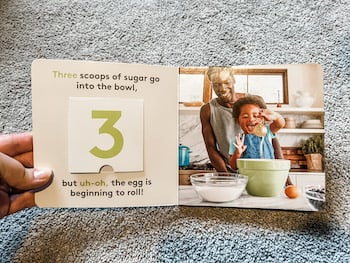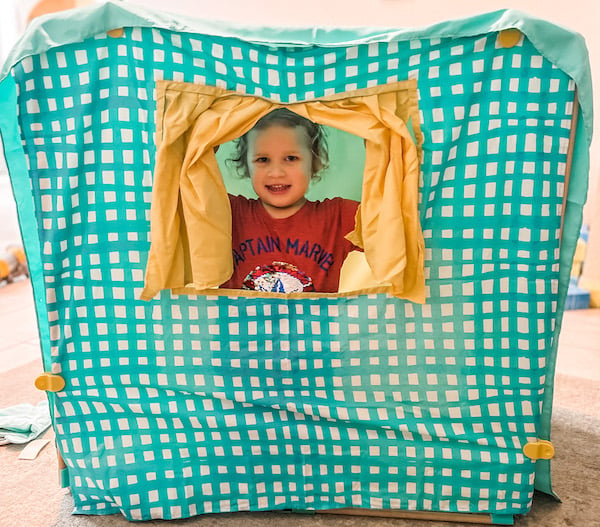As a parent, I want to provide my toddlers, whose ages currently span from 1 to 4 years old, with the best possible start in life. One educational approach we’ve dipped our toes into is the Montessori method.
There are so many benefits of the Montessori method, from building fine motor skills and language proficiency to promoting social and emotional growth.
I’ve rounded up 22 classic Montessori activity ideas you can do with your toddler.
Why Montessori-Aligned Activities?
The Montessori approach is a child-centered method that provides hands-on, experiential learning that’s both engaging and effective for toddlers.
The Montessori approach recognizes that toddlers have a curious nature and an innate drive to learn. It fosters this by providing a rich and stimulating environment where they can explore, experiment, and grow.
From my experience, the Montessori philosophy is all about following the child and letting them explore what they’re curious about. Give them open-ended toys that spark imagination and creativity, and also involve them in day-to-day tasks like folding laundry, emptying the dishwasher, and cooking dinner.
I love that this teaching style is so focused on raising capable humans who are allowed to tap into their interests!
Note: I have chosen not to send my kids to a Montessori school, for a variety of reasons, but cost is a major one. We do, however, practice a lot of Montessori principles in our house, though we are definitely not 100% Montessori (for example, we don’t do floor beds and we have a few plastic toys in our house). I think you have to look at the different educational and parenting approaches and do what’s best for your family, but there’s a lot to love with the Montessori approach!
Related: Top 10 Fun Montessori Play Silks Activity Ideas
Sensory Exploration Activities
Many sensory materials in a Montessori classroom can help introduce toddlers to various sensations. Here are some sensory activities you can try at home.
1. Water play

Water play is a sensory exploration activity that offers a fun and engaging experience for toddlers in a Montessori setting. This activity allows them to experiment with temperature and the properties of liquids, providing opportunities for sensory development and scientific exploration.
Pouring and experimenting with water also promotes creativity and imaginative play as toddlers fill their cup and pour it out, helping to build fine motor skills along the way.
2. Sensory bins filled with different textures and materials
Sensory bins filled with different textures and materials offer a wealth of sensory exploration opportunities for toddlers. This hands-on experience allows toddlers to explore and experiment with a variety of textures and materials, promoting sensory development and curiosity.
Sensory bins can also improve fine motor skills as toddlers manipulate the materials and engage in imaginative play, helping to build hand-eye coordination and dexterity. Additionally, sensory bins can provide opportunities for social development as toddlers share and play with peers, encouraging cooperation and problem-solving skills.
I absolutely love using beans in our sensory bin. Heads up: it makes a big mess if you walk away for a few minutes, but my kids have actually gotten used to grabbing the broom and sweeping it up, which is a great life skill!

Related Reading: 7 After-School Routine Ideas to Help Reduce Screen Time
3. Cooking and food preparation
This hands-on experience allows toddlers to explore and experiment with different textures, tastes, and smells, promoting sensory development and a love of cooking and healthy eating habits.

Cooking and food preparation also improve fine motor skills as toddlers mix, measure, and pour ingredients and engage in imaginative play as they create and explore food.

Additionally, cooking and food preparation can provide opportunities for social development as toddlers work together, take turns, and share their creations.
Fine Motor Skill Activities
The Montessori approach emphasizes the development of hand-eye coordination and other fine motor skills. Here are some activities you can try at home.
1. Stringing beads

Stringing beads also provide opportunities for imaginative play and creativity as toddlers create and decorate their own unique bead designs. Stringing beads can also promote language development as toddlers learn new vocabulary words related to colors, shapes, and sizes and engage in conversation with peers and adults.
Stringing beads is a valuable fine motor skill activity for toddlers in a Montessori setting. This hands-on experience requires concentration and coordination as toddlers manipulate the small beads and string them onto a cord or thread, promoting dexterity and hand-eye coordination.

2. Pouring and transferring with funnels and containers
Pouring and transferring with funnels and containers can be a great activity to help children strengthen their fine motor skills. It requires using their hands to manipulate the funnels and containers to move the objects.

This activity can be made fun by introducing different objects to pour and transfer, such as changing the size of containers or adding different shapes of objects. It helps kids practice hand-eye coordination and learn more about spatial awareness and motor planning.
Kids can also learn more about concepts, such as volume and size, while having fun with the activity. I love doing pouring and transferring practice while cooking! It takes patience on the parent’s part (I gotta check myself with a deep breath sometimes…) but it’s worth it.

3. Cutting with child-safe scissors
Cutting with scissors is an activity that encourages hand-eye coordination, encourages children to practice their pencil grip, and helps them become more familiar with using scissors.
There are lots of great scissors that are totally safe for toddlers to use. We have these from Amazon (about $6) and enjoy them!

When introducing this activity, it is important to start with simple shapes that are easy to cut and to offer plenty of encouragement. Once the child has become more accustomed to using the scissors, they can begin to tackle more complex shapes and designs. With practice and patience, they can hone their skills and have fun.
We have had a lot of fun doing different types of lines on a sheet of paper. You instruct your toddler to follow the line with the scissors. It’s a great place to start!

4. Using busy boards or latch-style toys
Busy boards are a great way to let little hands manipulate different challenges. Typically, a busy board will have components like locks, zippers, latches, and wheels – different things that a child can experiment with and “figure out.”
We absolutely love toys with these components, because they foster independent play, and they’re also clutch for long car rides.

We have several items from Lovevery play kits that have busy board qualities, but I also have a round-up of fantastic busy boards you can buy from places like Amazon.
These are really great for fine motor skills as your toddler will manipulate different components with their fingers. It might be frustrating for them at first, but over time, they’ll become a pro!
Outdoor Activities
Outdoor activities are a great way for toddlers to get fresh air and exercise. When you spend time together outside, it can help strengthen the bond between you and your child, as well as make them feel more comfortable in their natural environment.

Here are some ways you can engage in outdoor activities with your toddler:
1. Nature walks and scavenger hunts

During these outdoor activities, children can explore the natural world around them and discover new sights, sounds, and smells while also honing their observational skills.
Nature walks and scavenger hunts can also be combined with other activities to make them more engaging, such as counting how many different colors of leaves they can find or making a game of finding different shapes of rocks.
Kids can find SO many fun and unique things to do outside if you let them!

With a little creativity and guidance, nature walks and scavenger hunts can be enjoyable and educational experiences for toddlers.
Related: Fourth of July Scavenger Hunt Printable
2. Gardening and growing plants
Gardening and growing plants can be another great way to help children learn about the world around them.

It can help them develop their fine motor skills and hand-eye coordination and encourage a deeper connection with nature.

Children can practice watering the plants by following along with you or watering them on their own.

It will also allow them to play in the dirt and get messy, which most toddlers love to do.
3. Building and construction with loose parts
Loose parts are another great way to get your toddler involved in creative and constructive play. You or your child can collect these items like sticks, rocks, and leaves.
Once they are collected, you can use them to complete a variety of different construction projects together. This is also a good opportunity to encourage your child to problem solve and develop critical thinking skills. Doing so will help them learn how to use the materials they have in the best way possible.

4. Washing station
At the end of the day, your toddler can take a bath. That’s what I remind myself when one of my kiddos starts scooping up dirt and rubbing it in their hair.
They have an absolute blast, so why not just embrace it?
Our nanny found this really cute washing station activity on Pinterest, and you just fill up one tray with dirt and another with water. Your toddler can have fun getting their tiny animal figurines dirty and then washing them off. It’s also a great lesson in opposites (dirty and clean!).

Language Development Activities
The Montessori approach to enriching language development for toddlers involves combining various interactive, hands-on activities with facilitated conversations and language opportunities.
Here are some activities you can try at home.
1. Sound trays
Sound matching and sorting games are fantastic language development activities for young children. They help children develop phonemic awareness by matching and sorting objects with similar sounds.
As young children learn to identify and recognize sounds, they can compare and sort things with similar-sounding words. This helps them to develop their vocabulary and language skills.
Sound trays are an especially easy way to practice this concept! Just grab a basket/tray and ask your child to place items inside that start with a certain letter. For example, can you find things in the house that start with the letter “b?” They might put a toy bee, a blanket, and a baseball in the basket.

We also liked doing this with colors when our kids were a little younger. I still do this when I need to occupy the kids for a moment. For example, who can find me three things that are yellow? And I can finish chopping up veggies without my kids pulling on my leg and driving me crazy.
Sound matching and sorting games foster problem-solving and critical thinking while helping children recognize the sounds of words and develop their auditory processing.
2. Reading books and storytelling

When children are exposed to stories, they can make connections between the characters and their own lives and pick up on the context and content of the story. Furthermore, reading books aloud to children helps them further explore the language they are exposed to and provides an opportunity to practice and develop their language skills.

Storytelling is also a great way to help children learn a language. Through storytelling, children can learn about characters, emotions, grammar, and much more. Additionally, it is a great way for children to engage in a creative activity that allows them to express themselves and capture their peers’ imaginations.
Reading books and storytelling are great activities to encourage language development in your toddler and will also help them to develop their imagination, critical thinking, and creativity.

3. Sign language and communication exercises
Teaching sign language can help children develop their communication skills, allowing them to express their needs and want even before they master verbal language. Using sign language can also help encourage children to engage in interactive conversations, as many of these activities involve two-way communication.
Sign language and communication exercises can also help children build motor skills and increase their understanding of social cues. For instance, activities such as role-play can help children practice using nonverbal communication like facial expressions and body language.
These are a few signs experts recommend starting with:
- Mom
- Dad
- Eat
- Milk
- Cat or Dog
- More
- All Done
Here’s a helpful video from Pathways to get you started:
We use more and all done ALL the time in our house. My son is 11 months, and he definitely recognizes what these signs mean! He hasn’t mastered the motions yet, but his face lights up when I do a sign, say the word, and that’s what he wants.
Mathematical Activities
Mathematical activities are a fundamental part of the Montessori approach. Children learn to make sense of numbers, relationships, and patterns through these activities. Here are some great ways you can help your child develop their mathematical skills.
1. Counting and sorting objects
Counting and sorting objects are important mathematical activities that can help children develop their numerical and organizational skills. Children become more familiar with basic mathematics concepts by engaging in this activity and learning to recognize patterns and similarities.

This not only helps them gain an understanding of how numbers, shapes, and sizes relate to one another, but it also helps them better understand the world around them. Counting and sorting objects can be done in a variety of ways, including numbering and sorting by color, size, or shape.

Working with various objects, such as coins, beads, or blocks can help children understand how different objects can be used to solve problems or create patterns. Counting and sorting objects can also be a great way to teach children how to sequence events and actions.
2. Measuring and weighing using common household items
Measuring and weighing are great mathematical activities for toddlers. With a few simple household items, toddlers can start to build an understanding of spatial relationships and compare objects. Try having your toddler measure items like spoons and cups with a ruler or measure a piece of paper with a paper clip. You can also have them weigh items like apples or toys with a kitchen scale.
We love using the weigh scale that comes in this Lovevery kit, but there are lots of options out there!

Showing your toddler how to measure and compare items helps them to develop a deeper understanding of mathematics. It can also be a fun activity for them to do together with you or other children. You can also have your toddler draw pictures of what they measured and weighed to help them visualize the concepts they are learning.
3. Introducing numbers and basic arithmetic
Basic arithmetic and numbers can be introduced in a variety of different ways. Children can begin to learn the concepts by counting objects in their everyday life. The number of toys in a basket or people at a table can be used as a simple indicator.
I love books for this, too. Some books are obviously about numbers and counting, but you can count and talk about numbers in any type of book! (How many birds are on the page?) I learned a lot about this concept in this Lovevery podcast episode, which I highly recommend: How soon should children learn numbers & math?


Additionally, parents can introduce basic math concepts like numbers, patterns, and relationships through games and activities. For instance, you can play bingo or Candyland with your toddler or let them help you create designs with items around the house.
Cultural and Creative Activities
Cultural and creative activities are an important part of the Montessori approach. They allow children to learn about various cultures throughout history while exploring their uniqueness. They can help children develop abstract thinking skills and foster creativity and imagination.
1. Little Passports
A fun way to expose your toddlers to other cultures and places around the world is through the “Early Explorers” Little Passports subscription. We got this for 6 months and enjoyed it! You get a little suitcase with a wall-sized world map that you use to chart your travels each month.

One of my toddlers’ favorite boxes was foods around the world. We got to learn about what types of foods different cultures enjoy, and there were fun felt toys included that let us assemble them ourselves.

2. Art and craft projects using natural materials

Art and craft projects are a great way for children to explore a variety of different materials and learn about the world around them. They can help children develop their motor skills, solve problems, and learn about the design process.
These projects can encourage children to experiment with materials they may not be familiar with while also letting them create something beautiful they can take pride in.
Depending on your child’s age, you can begin by helping them create simple art projects using reused objects or recycled materials.

3. Music and movement games

Music and movement are great ways to bring fun into your toddler’s everyday routine. These activities can help build coordination, strength, and balance while encouraging them to move their bodies. You can start by playing simple rhythm games like clapping or clapping out the pattern of a song.
You can also play simple dance games or play instruments with your children. Doing so can help encourage toddlers to get active and develop their motor skills.
I also love using play silks for musical activities like learning about staccato and legato. Sarah’s Silks are the best of the best!
4. Dramatic play and pretend scenarios
Engaging in dramatic play and pretend scenarios allows children to develop critical thinking skills. They learn to use logical reasoning and problem-solving strategies while developing communication skills through these activities.

These activities help children gain an understanding of how things work, as well as allow them to practice the social skills they are learning in the classroom. They can also help foster creativity and let your child develop unique perspectives and ideas about the world.
5. Cook recipes from around the world
Another great cultural activity to do is make some recipes from other countries and cultures. I have such fond memories of a day in middle school when everyone brought in a Mexican food dish, and we got to learn about its history and enjoy it at the same time!
You can bring this concept into your home for your toddler just by researching different popular recipes, but if you want a done-for-you option, we really loved eat2explore.

This food subscription box for toddlers and kids not only provides you with recipes from around the world, but it includes hard-to-find ingredients, like specialty spice mixes or sauces. It adds authentic flavors without you having to track down the ingredients.

Plus, my kids really enjoyed most of the recipes we made together!

Conclusion
I hope these Montessori activities have inspired you to try new things in your home! They’re all loads of fun for your toddler, and you can feel good knowing they’re getting educational benefits in the process.
Let me know what your fav classic Montessori toddler activity is in the comments!
Note: Special shoutout to Andrea Gibbs, blog contributor at Montessori Academy. She gave me tons of ideas and pointers for this post! Thanks, Andrea!














